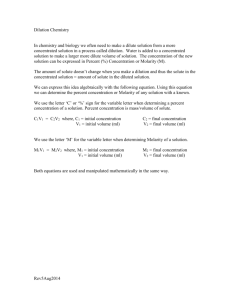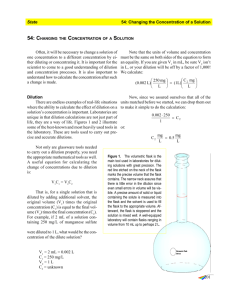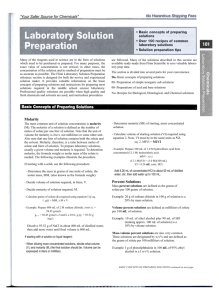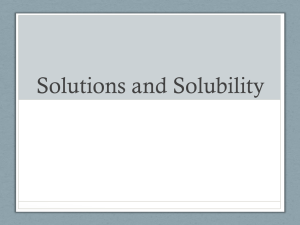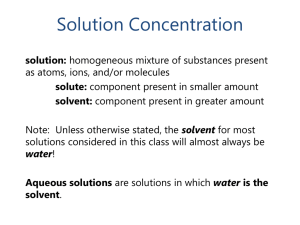Flinn-07_Preparing
advertisement
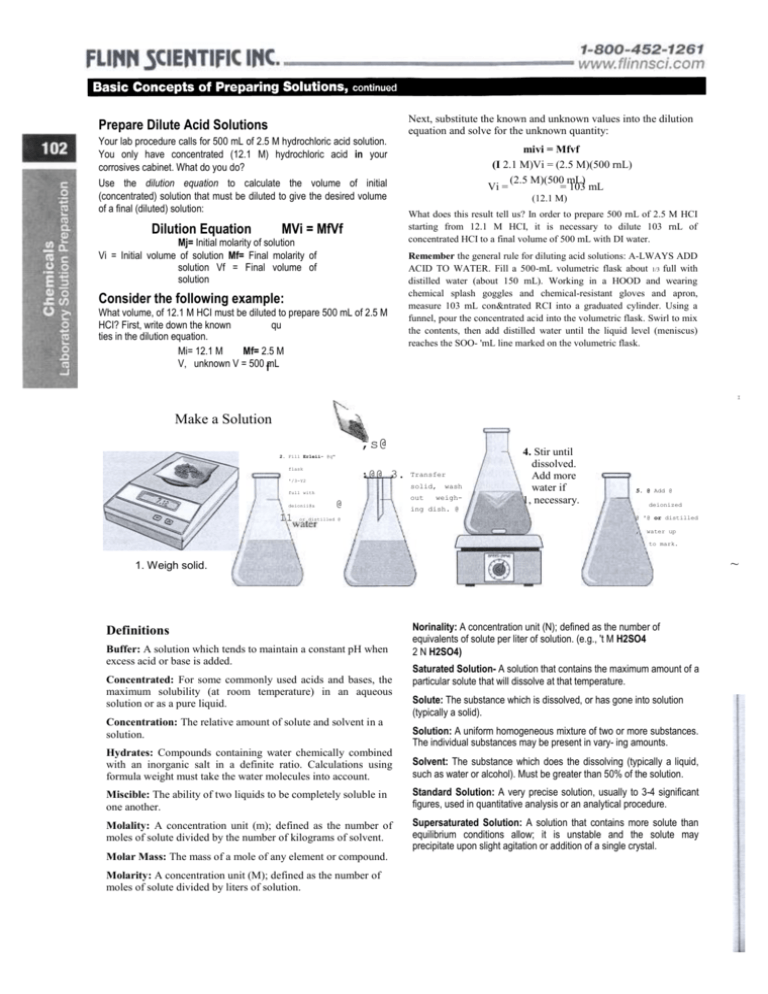
Prepare Dilute Acid Solutions Your lab procedure calls for 500 mL of 2.5 M hydrochloric acid solution. You only have concentrated (12.1 M) hydrochloric acid in your corrosives cabinet. What do you do? Use the dilution equation to calculate the volume of initial (concentrated) solution that must be diluted to give the desired volume of a final (diluted) solution: Dilution Equation MVi = MfVf Mj= Initial molarity of solution Vi = Initial volume of solution Mf= Final molarity of solution Vf = Final volume of solution Consider the following example: What volume, of 12.1 M HCI must be diluted to prepare 500 mL of 2.5 M HCI? First, write down the known qu ties in the dilution equation. Mi= 12.1 M Mf= 2.5 M V, unknown V = 500 fmL Next, substitute the known and unknown values into the dilution equation and solve for the unknown quantity: mivi = Mfvf (I 2.1 M)Vi = (2.5 M)(500 rnL) (2.5 M)(500 mL) Vi = = 103 mL (12.1 M) What does this result tell us? In order to prepare 500 rnL of 2.5 M HCI starting from 12.1 M HCI, it is necessary to dilute 103 rnL of concentrated HCI to a final volume of 500 mL with DI water. Remember the general rule for diluting acid solutions: A-LWAYS ADD ACID TO WATER. Fill a 500-mL volumetric flask about 1/3 full with distilled water (about 150 mL). Working in a HOOD and wearing chemical splash goggles and chemical-resistant gloves and apron, measure 103 mL con&ntrated RCI into a graduated cylinder. Using a funnel, pour the concentrated acid into the volumetric flask. Swirl to mix the contents, then add distilled water until the liquid level (meniscus) reaches the SOO- 'mL line marked on the volumetric flask. I Make a Solution ,s@ 2. Fill Erleii- @q" flask :@@ 3. '/3-Y2 deionii@a 11 Transfer solid, full with @ or distilled @ out wash weigh- ing dish. @ 4. Stir until dissolved. Add more water if 1, necessary. 5. @ Add @ deionized @ '@ or distilled , water up to mark. ~ 1. Weigh solid. Definitions Buffer: A solution which tends to maintain a constant pH when excess acid or base is added. Concentrated: For some commonly used acids and bases, the maximum solubility (at room temperature) in an aqueous solution or as a pure liquid. Concentration: The relative amount of solute and solvent in a solution. Norinality: A concentration unit (N); defined as the number of equivalents of solute per liter of solution. (e.g., 't M H2SO4 2 N H2SO4) Saturated Solution- A solution that contains the maximum amount of a particular solute that will dissolve at that temperature. Solute: The substance which is dissolved, or has gone into solution (typically a solid). Solution: A uniform homogeneous mixture of two or more substances. The individual substances may be present in vary- ing amounts. Hydrates: Compounds containing water chemically combined with an inorganic salt in a definite ratio. Calculations using formula weight must take the water molecules into account. Solvent: The substance which does the dissolving (typically a liquid, such as water or alcohol). Must be greater than 50% of the solution. Miscible: The ability of two liquids to be completely soluble in one another. Standard Solution: A very precise solution, usually to 3-4 significant figures, used in quantitative analysis or an analytical procedure. Molality: A concentration unit (m); defined as the number of moles of solute divided by the number of kilograms of solvent. Supersaturated Solution: A solution that contains more solute than equilibrium conditions allow; it is unstable and the solute may precipitate upon slight agitation or addition of a single crystal. Molar Mass: The mass of a mole of any element or compound. Molarity: A concentration unit (M); defined as the number of moles of solute divided by liters of solution.


